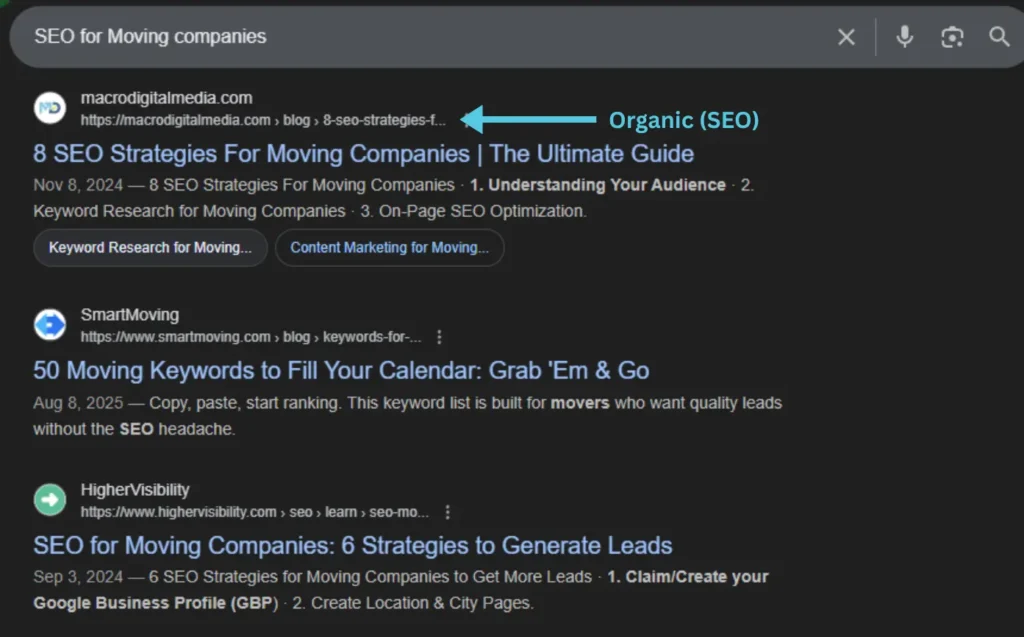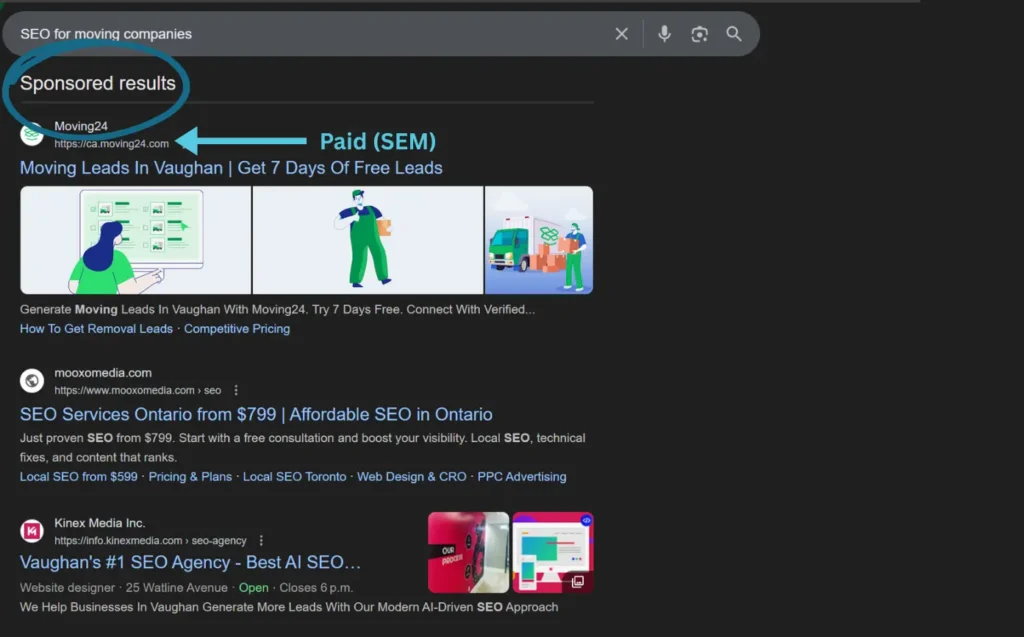The debate over SEO vs. SEM is one every marketer faces at some point.
Both strategies aim to increase visibility on search engines, yet they take very different paths to get there.
In this guide, we’ll break down what truly sets SEO vs. SEM apart, how each works, and when to invest in one or both for maximum results.
Understanding SEO (Search Engine Optimization)
To understand how SEO differs from SEM, we first need to explore what SEO really is and how it helps your brand grow organically over time.
What Is SEO?

Search Engine Optimization (SEO) is the process of improving your website to rank higher on search engines like Google without paying for ads.
It’s all about attracting the right audience through relevant keywords, quality content, and a smooth user experience.
When done right, SEO helps your business appear in front of people who are already searching for what you offer.
For example, if someone types “digital marketing agency in Toronto,” and your site ranks at the top organically, you’ve earned that visibility through SEO.
This makes SEO one of the most sustainable and cost-effective marketing channels available today.
Key Components of SEO
SEO has three main pillars that work together to boost visibility and authority:
On-Page SEO
This focuses on optimizing what’s directly on your website such as keywords, meta tags, headings, and content.
Following an on-page SEO checklist helps ensure every page is fully optimized for both search engines and users, making it easier for Google to understand your site’s topic and intent.
Example: adding target keywords naturally in headings and improving title tags for better click-through rates.
Off-Page SEO
This involves building your website’s reputation and authority across the web mainly through backlinks, brand mentions, and digital PR.
The more credible sites that link to you, the more trustworthy Google considers your business.
Technical SEO
Behind the scenes, technical SEO ensures your website performs smoothly.
It covers aspects like page speed, mobile optimization, site architecture, and indexation all crucial for helping search engines crawl and rank your pages efficiently.
Benefits of SEO
Investing in SEO brings long-term results that continue to grow over time.
- Cost efficiency: Once you rank, you keep attracting traffic without paying per click.
- Trust & credibility: Users naturally trust organic results more than ads.
- Compounding returns: Every optimized page strengthens your overall online presence.
- Better user experience: SEO improvements (like faster load times and better navigation) directly enhance engagement and conversions.
In short, SEO focuses on earning organic visibility through quality content, technical precision, and strong authority signals.
For multi-location businesses, implementing a franchise SEO strategy ensures each branch ranks locally while supporting overall brand authority.
It’s a long-term approach that rewards consistency and expertise making it the backbone of sustainable digital marketing success.
Understanding SEM (Search Engine Marketing)
While SEO focuses on earning visibility naturally, Search Engine Marketing (SEM) accelerates growth through paid strategies.
It’s the shortcut to getting your brand seen right away but it comes with its own rules and structure.
What Is SEM?

Search Engine Marketing (SEM) is a paid strategy used to promote websites by increasing their visibility in search engine results pages (SERPs).
Unlike SEO, where you earn traffic organically, SEM allows you to buy ad placements often appearing at the very top of search results.
The most common form of SEM is Pay-Per-Click (PPC) advertising, where you bid on keywords and pay only when someone clicks your ad.
For instance, a campaign targeting “Toronto moving company” could instantly bring traffic to your site, while SEO might take months to rank for the same keyword.
SEM delivers results fast which makes it ideal for time-sensitive campaigns, product launches, or testing new markets.
Core Elements of SEM
To run a successful SEM campaign, marketers need to master several moving parts that determine visibility, cost, and ROI.
Google Ads
Google Ads is the world’s largest SEM platform, offering both Search Ads (text-based) and Display Ads (visual banners).
It allows precise audience targeting based on keywords, demographics, and location.
Many multi-location businesses leverage Google Ads for franchise marketing to promote individual locations while maintaining brand consistency across campaigns.
Pay-Per-Click (PPC) Bidding Model
In SEM, advertisers compete in real-time auctions for ad placement.
Your Ad Rank depends on your bid amount and Quality Score (relevance and landing page quality).
A high-quality ad can often outperform higher bids.
Keyword Targeting and Ad Relevance
Success in SEM depends heavily on keyword research.
Selecting commercial-intent keywords (“buy,” “book,” “hire”) ensures your ads reach users who are ready to take action.
Understanding local search intent is equally important as it helps your ads appear in front of nearby users actively looking for services in their area.
Writing compelling ad copy that aligns with those keywords boosts click-through rates.
Benefits of SEM
SEM offers marketers several powerful advantages:
- Instant visibility: Get your business to the top of Google in minutes.
- Precise targeting: Reach the right audience based on location, behavior, and intent.
- Budget control: Set daily or campaign-specific limits to manage spend effectively.
- Data-driven insights: Campaign metrics reveal which keywords convert best, helping refine SEO strategy later.
In essence, SEM is about paying for strategic visibility.
It’s fast, measurable, and ideal for immediate results but it requires ongoing investment. When combined with SEO, it becomes a powerful tool for both short-term wins and long-term brand growth.
SEO vs. SEM: Key Differences
Now that we understand what SEO and SEM each do individually, it’s time to compare them side by side.
While both aim to improve visibility and attract potential customers, the way they achieve results and how fast they do it is what truly sets them apart.
Speed and Results
If you’re looking for quick wins, SEM delivers faster results than SEO.
Paid ads can appear at the top of Google within hours of launching a campaign, making SEM ideal for product launches or limited-time promotions.
SEO, on the other hand, is a long-term game.
It may take several months to rank on the first page, but once you do, you’ll continue attracting organic traffic without paying per click.
In short: SEM is about instant exposure, while SEO builds lasting authority.
Cost Structure
The financial models behind SEO and SEM differ completely.
- SEO requires an investment in content creation, website optimization, and link-building, but once rankings are achieved, the ongoing costs are relatively low.
- SEM operates on a pay-per-click basis — meaning every visitor costs you money. Stop spending, and your visibility disappears instantly.
That’s why many marketers use SEM for short-term campaigns and rely on SEO for long-term sustainability.
Sustainability
When it comes to staying power, SEO clearly takes the lead.
An optimized page can rank for years with occasional updates and maintenance.
SEM, however, offers temporary visibility once the campaign ends or budget runs out, your ads vanish.
A balanced digital strategy often combines both: SEM for immediate traffic and SEO for compounding growth.
ROI Timeline

- SEO: Slower to start, but offers compounding returns over time.
- SEM: Immediate traffic, but limited by ongoing costs.
Most marketers see the best ROI when they use both channels together.
For instance, data from SEM campaigns can help identify high-converting keywords to target organically through SEO.
At its core, SEO is a marathon, while SEM is a sprint.
Both can lead to the same destination more visibility and conversions but they follow different paths.
The smartest marketers don’t choose one over the other; they understand when and how to use each to achieve the best results.
How SEO and SEM Work Together
While SEO and SEM can deliver results independently, the real magic happens when they’re combined.
By aligning both strategies, marketers can maximize visibility, accelerate performance, and collect valuable data to refine long-term campaigns.
Shared Keyword Data
One of the biggest advantages of running SEO and SEM together is the data overlap.
SEM campaigns instantly reveal which keywords drive the highest conversions insights you can then use to prioritize your SEO content strategy.
For example, if your Google Ads campaign shows strong performance for “affordable digital marketing agency,” you can optimize your organic content around that keyword for sustainable results later.
In other words, SEM provides the quick data, and SEO uses that data for lasting growth.
Dominating SERPs
When both your paid ads and organic results appear on the same search engine results page (SERP), your brand presence doubles, often increasing click-through rates significantly.
This strategy, known as SERP domination, helps build credibility and trust. Users subconsciously view your brand as a leader when they see it repeatedly across both paid and organic placements.
A well-balanced mix of SEO and SEM ensures that your brand doesn’t just appear once — it owns the conversation in search results.
Retargeting Visitors
SEO brings in visitors organically, but not all of them convert right away. That’s where SEM steps in.
By using retargeting ads, you can re-engage users who previously visited your website through organic search.
For example, a user who read your blog about “SEO vs. SEM” could later see a paid ad offering a free marketing audit from Macro Digital.
This combination turns awareness into action, nurturing leads through multiple touchpoints until they’re ready to convert.
In short, SEO and SEM are not rivals, they’re complementary strategies.
SEO builds your foundation and authority over time, while SEM gives you instant visibility and data to improve faster.
When aligned properly, they form a powerful ecosystem that drives both short-term gains and long-term success.
Choosing the Right Strategy for Your Marketing Goals
Both SEO and SEM have their place in a well-rounded digital marketing plan.
The right choice depends on your goals, budget, and timeline.
Let’s look at when to prioritize each and how to combine them for the best outcome.
When to Focus on SEO
If your goal is to build long-term digital authority and reduce dependency on paid ads, SEO should be your priority.
It’s ideal for brands looking to create consistent organic growth, especially if you’re willing to invest time into quality content and technical optimization.
Choose SEO when:
- You’re focused on sustainable traffic and brand trust.
- You want to rank for informational or evergreen keywords.
- You’re building a strong online presence that compounds over time.
- You want better ROI in the long run with lower ongoing costs.
A local service business that invests in local SEO Services, optimizing Google Business Profile, collecting reviews, and publishing city-specific blogs will continue generating free leads for years after initial optimization. For example, local SEO for plumbers helps rank their services in nearby areas where customers actively search, driving steady traffic and high-intent leads.
When to Focus on SEM
SEM is perfect for businesses that need immediate visibility or want to test marketing ideas before going all in.
It’s also great for competitive industries where organic rankings take time to build.
Choose SEM when:
- You’re launching a new product or service.
- You need instant traffic or leads.
- You want to test keywords or offers quickly.
- You’re running seasonal or time-sensitive campaigns.
A moving company might run Google Ads for “last-minute movers Toronto” to instantly capture leads during peak season — something SEO alone might not deliver fast enough.
Balancing Both for Maximum Impact
The best marketers know it’s not about choosing one over the other, it’s about balance.
You can use SEM to drive quick results and gather keyword insights, then invest in SEO to turn those learnings into long-term organic wins.
When combined, SEO and SEM create a marketing flywheel: one fuels data and traffic, while the other builds authority and retention.
Ultimately, SEO builds your brand, while SEM amplifies it.
If you’re in it for the long game, invest in SEO. If you need immediate results, start with SEM.
But if you want to dominate search from every angle, use both strategically and let data guide your decisions.
Choosing the Right Strategy for Your Marketing Goals
Both SEO and SEM have their place in a well-rounded digital marketing plan.
The right choice depends on your goals, budget, and timeline.
Let’s look at when to prioritize each and how to combine them for the best outcome.
When to Focus on SEO
If your goal is to build long-term digital authority and reduce dependency on paid ads, SEO should be your priority.
It’s ideal for brands looking to create consistent organic growth, especially if you’re willing to invest time into quality content and technical optimization.
Choose SEO when:
- You’re focused on sustainable traffic and brand trust.
- You want to rank for informational or evergreen keywords.
- You’re building a strong online presence that compounds over time.
- You want better ROI in the long run with lower ongoing costs.
A local service business that invests in local SEO, optimizing Google Business Profile, collecting reviews, and publishing city-specific blogs will continue generating free leads for years after initial optimization.
When to Focus on SEM
SEM is perfect for businesses that need immediate visibility or want to test marketing ideas before going all in.
It’s also great for competitive industries where organic rankings take time to build.
Choose SEM when:
- You’re launching a new product or service.
- You need instant traffic or leads.
- You want to test keywords or offers quickly.
- You’re running seasonal or time-sensitive campaigns.
A moving company might run Google Ads for “last-minute movers Toronto” to instantly capture leads during peak season, something SEO alone might not deliver fast enough.
Balancing Both for Maximum Impact
The best marketers know it’s not about choosing one over the other, it’s about balance.
You can use SEM to drive quick results and gather keyword insights, then invest in SEO to turn those learnings into long-term organic wins.
When combined, SEO and SEM create a marketing flywheel: one fuels data and traffic, while the other builds authority and retention.
Summary
Ultimately, SEO builds your brand, while SEM amplifies it.
If you’re in it for the long game, invest in SEO. If you need immediate results, start with SEM.
But if you want to dominate search from every angle, use both strategically and let data guide your decisions.
FAQs
Is SEO part of SEM?
Technically, yes SEO is often considered a component of SEM, since both aim to improve visibility in search engines.
However, in modern marketing, SEO refers to organic optimization, while SEM focuses on paid advertising.
In other words, SEO earns visibility, and SEM buys it.
Which is better for my business, SEO or SEM?
It depends on your goals. If you’re looking for long-term, sustainable growth, SEO is your best investment.
But if you need immediate leads or fast visibility, SEM will deliver quicker results.
The most effective approach is to combine both, using SEM for short-term performance and SEO for lasting ROI.
Can SEO and SEM work together?
Absolutely. In fact, SEO and SEM complement each other perfectly.
SEM provides instant data and traffic, while SEO builds trust and authority over time.
When used together, they help you dominate search results, improve conversions, and strengthen your overall marketing performance.




